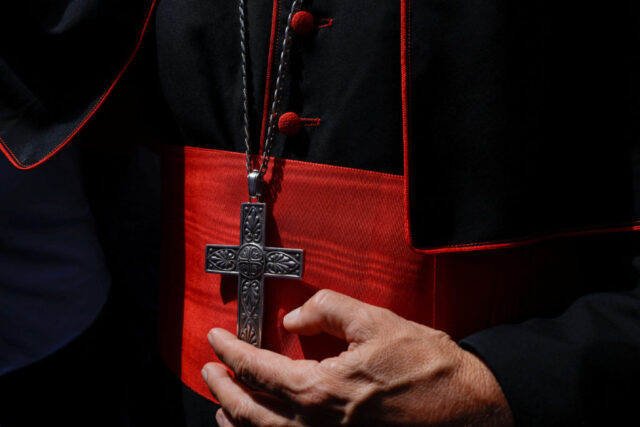

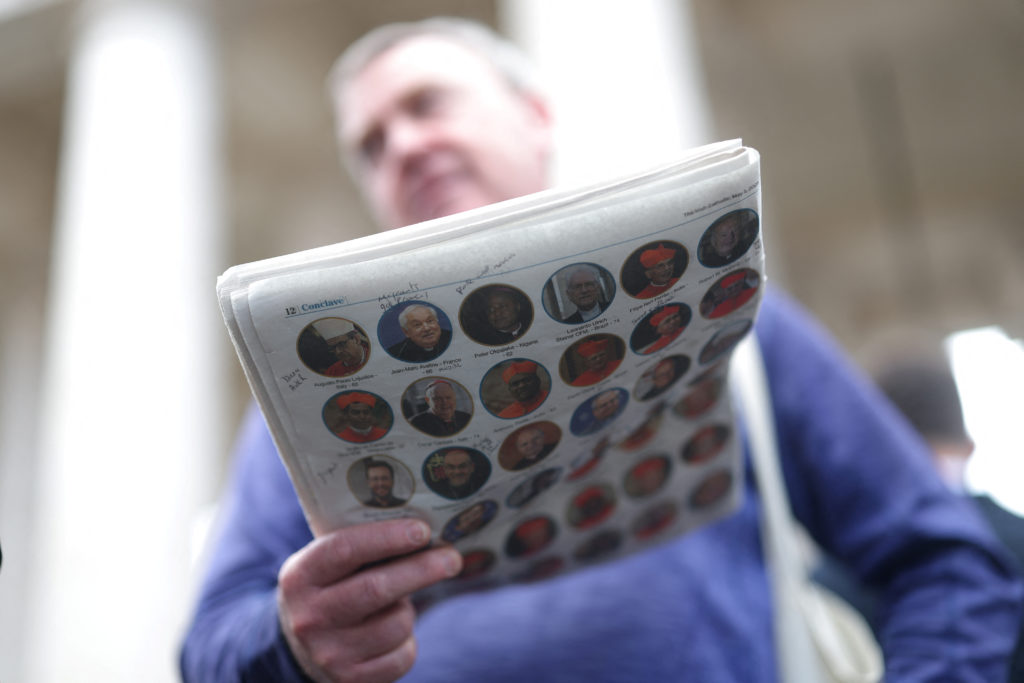

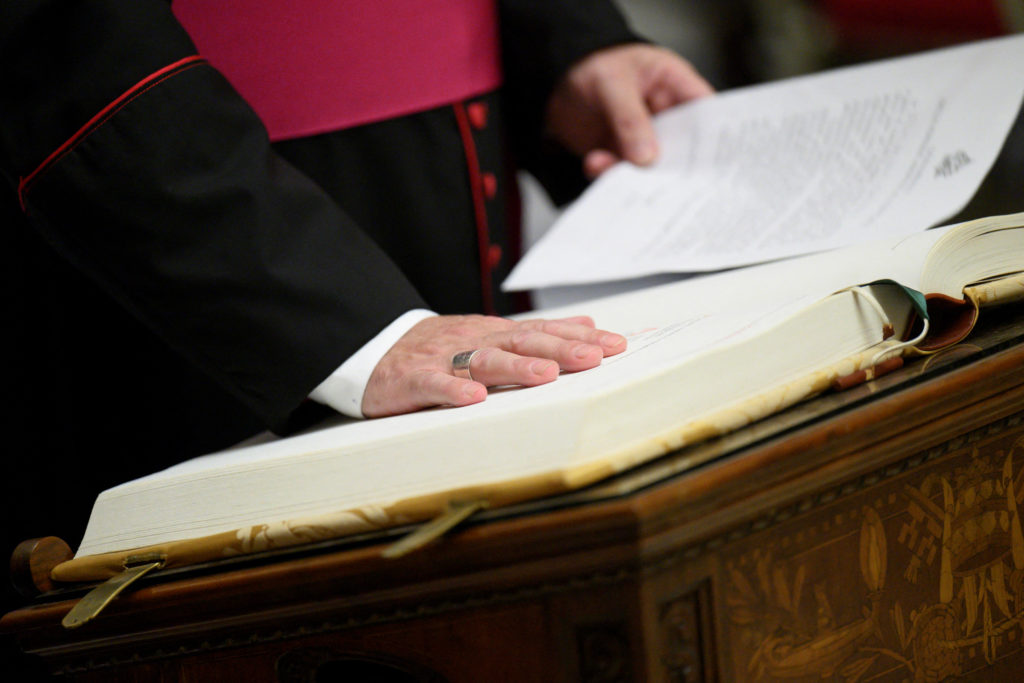


The conclave to pick a new pope begins May 7. Find a quick guide to that process, watch “Conclave” author Robert Harris explain the secretive tradition, and learn more about what the cardinals will be considering, and the importance of a pope’s choice of name.
“Extra omnes!”
The conclave to select the next pope kicks off once the Vatican’s master of papal liturgical celebrations utters the Latin phrase for “outside, all.”
READ MORE: How does the conclave pick a new pope? 8 things to know
What happens next will be a mystery to everyone outside of the Sistine Chapel.
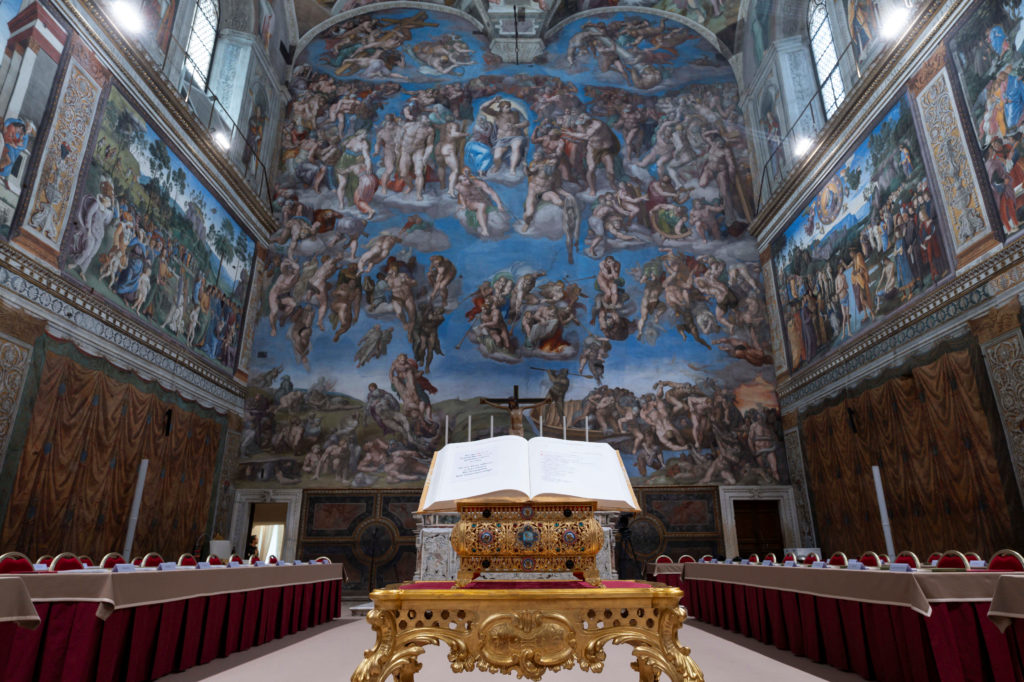
The inside of the Sistine Chapel ahead of the conclave to elect the next pope at the Vatican on May 6, 2025. Photo by Vatican Media/ Handout via Reuters
To understand how the next pope is selected, and what might take place inside the conclave, it’s important to know what happens ahead of time, professors of history, theology and law told PBS News.
A conclave pregame
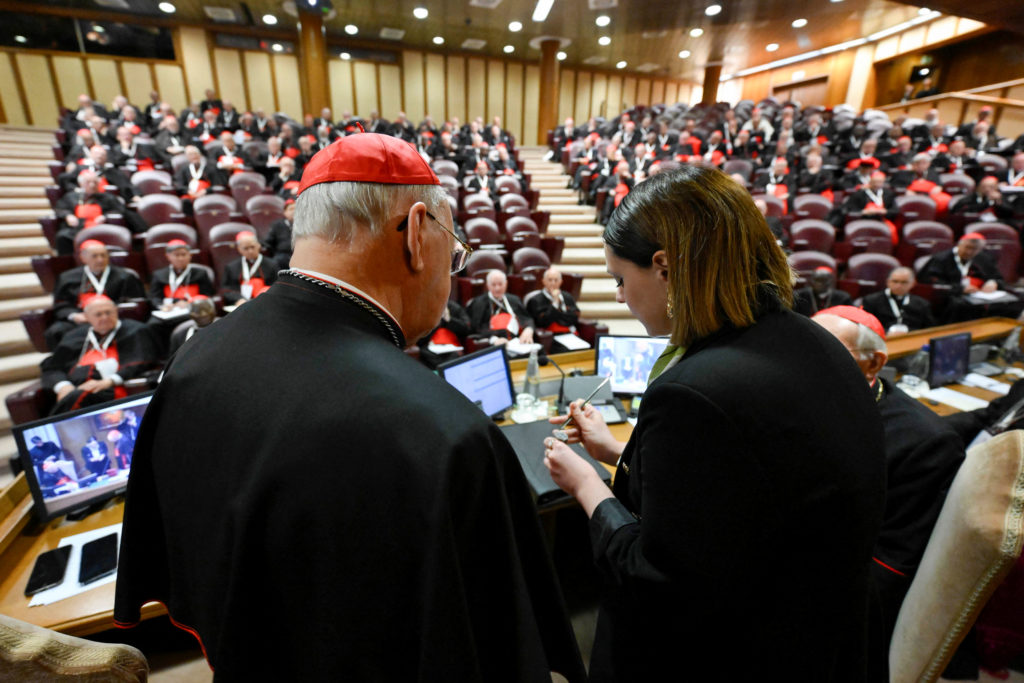
Cardinals participate in General Congregation, ahead of the Conclave, at the Vatican on May 6, 2025. Photo by Vatican Media/Handout via Reuters
Before a conclave, there’s a sort of pre-conclave. Cardinals take part in formal meetings known as general congregations to get to know one another, and to deliver speeches called “interventions” that usually touch on what the Catholic Church needs at that time.
The cardinals finished their pre-conclave meetings Tuesday, during which the cardinals reportedly agreed that they will need to select a pope who will bring renewed credibility and relatability to the Catholic Church.
READ MORE: Who will be pope? Meet some possible contenders
In 2013, an intervention delivered by Francis, then known as Cardinal Jorge Mario Bergoglio, is widely seen as helping move the cardinals to elect him, according to Kathleen Sprows Cummings, a professor of history at the University of Notre Dame.
In the speech, the Argentinian cardinal quoted from the last book in the Bible: “In Revelation, Jesus says that he is at the door and knocks. Obviously, the text refers to his knocking from the outside in order to enter, but I think about the times in which Jesus knocks from within so that we will let him come out,” he reportedly said in his speech.
“Bergoglio was a runner-up [to Pope Benedict XVI] in 2005. But in 2013, he wasn’t really on anybody’s radar because he was considered to be too old,” she said. But his speech “really got the cardinals … to say, maybe it’s him, maybe he’s the man we need.”
How much does the previous pope influence the picking of his successor?

A person walks past an image of late Pope Francis near the Vatican on May 5, 2025. Photo by Murad Sezer/ Reuters
The key question going into the conclave is to what extent the new pope continues Francis’ reforms, according to the Rev. Thomas Rausch, S.J., an emeritus professor of theology at Loyola Marymount University in Los Angeles. Those include his focus on bringing more voices of the faithful into the mission and decisions of the Church.
“Of course, there were some opponents of Pope Francis that are really pushing for a very conservative candidate, who would move the church in a different direction,” Rausch said. “And there are many others, including most of the bishops, most of the cardinals appointed by Francis, who presumably will be more in favor of continuing the direction he gave to the Church.”
READ MORE: ‘We need a superman!’ Cardinals wrap up pre-conclave meetings
In fact, Francis named 108 of the 135 eligible cardinal electors, or 80 percent, for this conclave. Two cardinals, both of whom were appointed by Benedict, have said they will not take part due to health reasons, bringing the total down to 133.
While the percentage is notable, it’s not unusual for the previous pope to have named most of the cardinals that will choose his successor, said Jeffrey Morrow, a professor of theology at Franciscan University of Steubenville.
According to Morrow, Benedict XVI named 58 percent of the cardinals who voted in the 2013 conclave; Pope John Paul II named 98 percent of the cardinals who voted in 2005; and Pope Paul VI named 90 percent of the cardinals who voted in the two conclaves of 1978.
“But it’ll have an effect,” Morrow said of the number of cardinals that Francis appointed, “because these are cardinals that he thought would do a good job in their role.”
Though church law dictates that the number of cardinal electors must not exceed 120, the pope can overrule this.
“The pope is conceived of, at canon law, as the supreme legislator, and – as the supreme legislator – the pope has the authority to supersede the written text,” said Charles J. Reid Jr., a law professor at the University of St. Thomas in Minneapolis. “By naming so many more cardinals, over 120, he has simply superseded the written text.”
Do ‘politics’ play a role in the conclave?

A man holds a newspaper with the list of cardinals in Rome on May 6, 2025. Photo by Hannah McKay/ Reuters
The cardinals are supposed to be influenced by the Holy Spirit to help discern who should be the next pope, Sprows Cummings said. That being said, lobbying does take place during the general congregation meetings, dinners and cocktail hours that the cardinals host.
“I don’t want to say that politics aren’t a part of it,” Sprows Cummings said. “But I will say that politics aren’t supposed to be a part. … We don’t want to call it politics. They’re certainly not campaigning. But how they would pitch it is they’re marshaling support for the person they believe the Church needs now.”
READ MORE: More than 130 cardinals will meet to choose the next pope. It will be the most geographically diverse conclave ever
In his 1996 apostolic constitution, John Paul II “earnestly” called on the cardinal electors “not to allow themselves to be guided … by friendship or aversion,” or to be influenced by their personal relationships, the media, “or by force, fear or the pursuit of popularity.”
Can a cardinal vote for himself during a conclave?
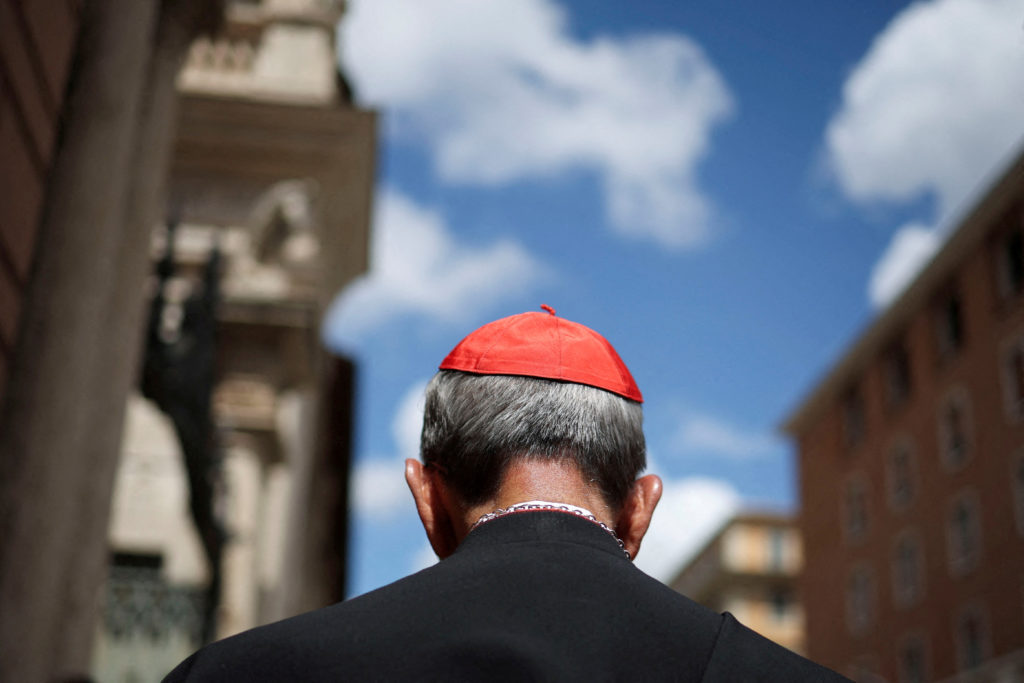
A cardinal walks ahead of the conclave to elect the next pope on May 6, 2025. Photo by Marko Djurica/ Reuters
The practice of voting for yourself in a conclave is “deeply frowned upon,” Reid said.
He recalled that when cardinals chose Pope Benedict XVI in the 2005 conclave, Benedict, then known as Cardinal Joseph Ratzinger, voted for Cardinal Giacomo Biffi, the archbishop emeritus of Bologna, Italy.
“Ratzinger felt it would be improper, inappropriate for him to vote for himself,” Reid said. “The thought behind it is, you should be called to the papacy, right? If you’re calling yourself, there’s something unseemly about that. Others should call you. You’re called, ultimately, theologically by the Holy Spirit, but collegially by your fellow cardinals.”
Is the 2024 movie “Conclave” an accurate depiction of a papal conclave?

Officials, members of the clergy and Conclave staff take Oath of Secrecy in Pauline Chapel at the Vatican on May 5, 2025. Photo by Vatican Media/Handout via Reuters
The Oscar-nominated film starring Ralph Fiennes, Stanley Tucci and John Lithgow is a fictional account that dramatizes the inner workings of a papal conclave.
Sprows Cummings said the movie “got so much right” and was “meticulously researched,” based on the clothing, the procedure of a conclave, the burning of the ballots and the idea that a single speech from a cardinal could sway the vote.
WATCH: ‘Conclave’ author Robert Harris on the secretive tradition of selecting a new pope
Yet, one key detail from the film is pure fantasy. Cardinal Benitez, played by Carlos Diehz, arrives just before the conclave and says he was named a cardinal in secret, or “in pectore,” by the late pope. Sprows Cummings said that, in reality, Benitez would not be permitted to vote in the conclave.
“A cardinal isn’t admitted to the rights of the office until [their appointment is] publicly announced,” she said. “So that wouldn’t happen.”
The movie also downplayed the role of general congregations in the process. “I was joking about the movie [that] nobody wants to make a Hollywood movie called ‘General Congregations,’” Sprows Cummings said.
Some of the cardinals’ outward politicking in the movie “was more Hollywood than history,” according to Rausch.
“But what they do is they say, ‘Well, what do you think about the archbishop of Kinshasa?’ ‘Well, he’s a good man, but a little conservative,’ you know. ‘And what about Berlin?’ ‘Well, he’s a fine man, very progressive,’” he said. “They’re kind of sounding each other out about what they think of the various cardinals and especially those that might be candidates for the papal office.”
How do the cardinals use black and white smoke to communicate?

Firefighters install a chimney on the roof of the Sistine Chapel, ahead of the conclave, at the Vatican on May 2, 2025. Photo by Vatican Media/Handout via Reuters
While in conclave, the cardinals swear an oath not to communicate through writing or conversations with anyone on the outside. The Vatican uses technology to block electronic signals and other interference to prevent leaks and protect the proceedings. To communicate their progress, they fall back on a traditional solution with some modern updates.
The cardinals vote with paper ballots in successive rounds until someone receives the two-thirds majority required for election. Once a round of voting concludes, the ballots are burned inside a stove (workers just installed one in the Sistine Chapel over the weekend). Those ballots are mixed with chemical recipes, first adopted in 2005, to make the color of the smoke more distinct.
If no one garners enough votes, the ballots are mixed with cartridges of potassium perchlorate, anthracene (a component of coal tar) and sulfur to produce black smoke that emanates from a chimney out of the chapel. If someone has been elected pope, potassium chlorate, lactose and chloroform resin are mixed with the ballots to produce white smoke – and cheers erupt from the crowd eagerly watching the chimney for news in St. Peter’s Square.

A view of the interior of the Sistine Chapel ahead of the conclave to elect the next pope. Photo by Vatican Media/Handout via Reuters
Support PBS News Hour
Your tax-deductible donation ensures our vital reporting continues to thrive.





































